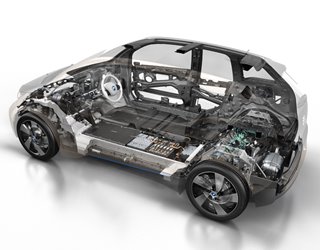
Amory Lovins says taking energy-efficient design to the extreme can pay off in big ways.
Ask an engineer his or her opinion of what should be done to respond to the climate challenge, and the chances are good that they will talk about new technology. That is understandable. After all, the most high-profile projects have involved such new, or newly improved technologies as solar photovoltaic panels, massive wind turbines and sleek battery-powered electric vehicles.
While these breakthroughs are already showing impressive benefits, another facet of engineering is actually making significantly larger contributions: design. Between 2010 to 2016, according to the International Energy Agency, renewables’ 45-percent growth contributed a modest one-fourth of the total achieved global decarbonization. Where did the rest come from?
Energy savings—roughly two-thirds of which, according to IEA, was from more-efficient end-use technologies.
Efficiency is the cornerstone of engineering. When designing a new product, engineers are trained to shave unnecessary ounces and eliminate needless power draws. But only up to a point. Enough is enough. Any more is considered a waste of money and resources.
Sometimes, though, the real breakthrough occurs when a designer reconsiders how much is enough.
Amory Lovins, cofounder of Rocky Mountain Institute in west-central Colorado, likes to tell the story of when he was building a house in Old Snowmass, a high mountain town where winter temperatures have been known to dip into the -40s. He wanted to design a house that would require as little energy as possible, while still remaining comfortable enough that he’d want to live in it.
He kept pushing his co-designers for more insulation, going well beyond conventional practice. The team had been taught to “stop adding insulation at the point where adding more will no longer save enough energy to pay for itself.” This rule of thumb, said Lovins, “seems to make sense—except it’s wrong, because it leaves out the capital cost of the heating equipment.”
Radical Efficiency
Lovins started turning his attention to energy issues even before the oil crises of the 1970s upended the world economy. And his focus on energy efficiency can be seen as a response to the twin problems of that era: restrictions of the oil supply and the reluctance to build more nuclear reactors.
While it is not always wise to reskin an old argument for a new reality, Lovins can point to data showing that energy efficiency is an unsung hero in the 21st century fight against climate change. Lovins popularized the term “negawatt” in the 1980s to try to put efficiency measures on the same footing as new generating capacity; since 1975, Lovins and his team at RMI have calculated negawatts in the form of a lower energy intensity in the U.S. economy cumulatively outstripped the growth of renewables by a factor of 28 to 1.
In his 2011 book, Reinventing Fire, Lovins and more than 60 colleagues described how the U.S. could reduce carbon emissions by up to 86 percent by 2050, while saving $5 trillion in today’s dollars and maintaining economic growth—all using then-current technology and laws.
More About Efficiency: Renewable Energy’s Efficiency Tool
The nation is broadly on track to meet that vision, Lovins recently said. Now Lovins is on a mission to accelerate that progress through a process called integrative design.
Integrative design is scarcely taught in engineering schools, yet it offers nearly unlimited potential to unlock what Lovins calls “radical energy efficiency.”
Lovins described the concept as “optimizing buildings, vehicles, factories, and equipment as whole systems for multiple benefits, not piles of isolated parts for single benefits.” The process, he said, saves both energy and capital cost. The Lovins house in Old Snowmass is a prime example of this: Hardly a one-off, the house has become a model for a passive building movement that helped inspire hundreds of thousands of imitators, largely in Europe, where similar results are consistently achieved at roughly normal construction costs (give or take a few percent—“if it’s done right”).
Other noted building projects include a retrofit of the Empire State Building that reduced energy consumption by 40 percent with a three-year payback and a deep energy retrofit of the Byron G. Rogers Federal Building, a 1960s modernist high-rise in Denver, which now requires less energy than most of the best new office buildings in the country. Those renovations used widely available technologies; what mainly changed is how those technologies were chosen and combined.
Starting at the Conclusion
Unlike other stories, whodunits are written backward: figure out the ending and then develop the rest of the plot to reach that point. Integrative design works much the same way, inasmuch as its advocates say one should start with the desired outcome, and then work backward. For instance, if the objective is to move a 150-pound person across town, is a 4,000-pound vehicle the most efficient way to do that?
This principle applies in spades to pump and piping systems. Electric motors use around half the world’s electricity, and half their torque runs pumps and fans. In a typical pumping system, only about 10 percent of the fuel energy going into the power plant ultimately comes out of the pipe as flow. Turning these compounding losses around into compounding savings makes one unit of saved flow or friction in the pipe save about 10 units of fuel, cost, and pollution back at the power plant.
Car Concepts
If pumps and piping generally lurk under the skin of the built infrastructure, automobiles are some of the most visible technology on the planet. Lovins applied the integrative design approach to cars to create a concept car that goes far beyond what most engineers thought was possible.
Again, the key was looking at the desired result—in this case, moving someone from point A to point B—and working backward from there. According to Lovins, only 0.3 percent of the fuel energy consumed actually moves the driver. About 80 percent is lost before it even reaches the wheels; of the remainder, half is lost to air drag, the rest to heating the tires and road or to accelerating the vehicle mass and then heating the brakes when stopping.
Importantly, roughly 95 percent of the mass of a car in motion is the steel vehicle; only 5 percent is the driver. Engineers are taught to compute the efficiency of a system by multiplying the efficiencies of each element together. The transitive property states that order doesn’t matter for multiplication, but Lovins argues that is not the case in design. Savings should start at the end—all the way downstream, where the desired service is delivered. Saving one unit of energy at the wheels saves another 4 units now lost getting that energy to the wheels.
Lovins and his team started applying these sorts of principles to car design in the 1990s, looking for ways to increase efficiency.
“First make the car light and slippery to cut its mass and drag,” he recalled. “That requires a smaller and lighter powertrain and smaller and lighter chassis components, which, in turn, weigh even less. This also leaves more packaging space for comfort and more crush space for safety. Repeat this in an iterative process where lightness begets lightness. Shrink and eliminate components.”
Paraphrasing Antoine de Saint-Exupéry for emphasis, Lovins added, “True simplicity is achieved not when there is nothing more to add, but when there is nothing left to take away.”
The result of all that whittling was the Hypercar, an ultralight hybrid-electric vehicle that would achieve a factor of 3 or 4 gains in fuel economy, compared to conventional cars or SUVs. (One version called for hydrogen fuel cells to make electricity for an even more efficient electric drive.) Much of the savings in weight would come from building the Hypercar from carbon-fiber instead of steel.
RMI is not an automaker, and a spin-off company switched to advanced composites manufacturing technology before running out of capital. But the concepts identified in the Hypercar project are slowly being adopted by major manufacturers.
For instance, when BMW began designing its i3 electric vehicle, it used many of the same principles as the Hypercar. When the i3’s designers first considered using carbon-fiber for the car’s body, they were told it would be far too expensive. But just like Lovins’s group at RMI, when they looked at the big picture, they realized that the extra cost would be offset by the ability to use smaller, cheaper batteries to propel the much lighter car. Fewer batteries also recharge faster. The lightweight moldable body also greatly simplified manufacturing—yielding a competitive price.
Why have such design approaches been overlooked? And why can engineering students often complete a full course of study without being taught integrative design? Too often, it seems that we are taken with deploying new technologies or exploiting new resources. For instance, engineers scramble to find new uses for Internet of Things-enabled devices, and companies work to roll out solar and wind power at heretofore unimaginable scales.
“Unlike oil or copper, most energy efficiency reserves cost less than the ones we are now exploiting,” Lovins wrote in a 2018 peer-reviewed summary of integrative design, “because they come from not adding more or fancier widgets but from using fewer and simpler widgets—more artfully chosen, combined, timed, and sequenced.” They come not from adding more stuff but from designing stuff out. This is unlike mineral reserves—“finite assemblages of atoms”—whose depletion raises costs.
Fortunately, the gains that Lovins has spent his career pointing out are simply there for the taking, waiting for necessity and ingenuity to combine. “Energy efficiency reserves are infinitely expandable assemblages of ideas that deplete nothing but stupidity,” Lovins wrote, adding that is “a very abundant if not expanding resource.”
R.P. Siegel is a technology writer based in Rochester, N.Y.



